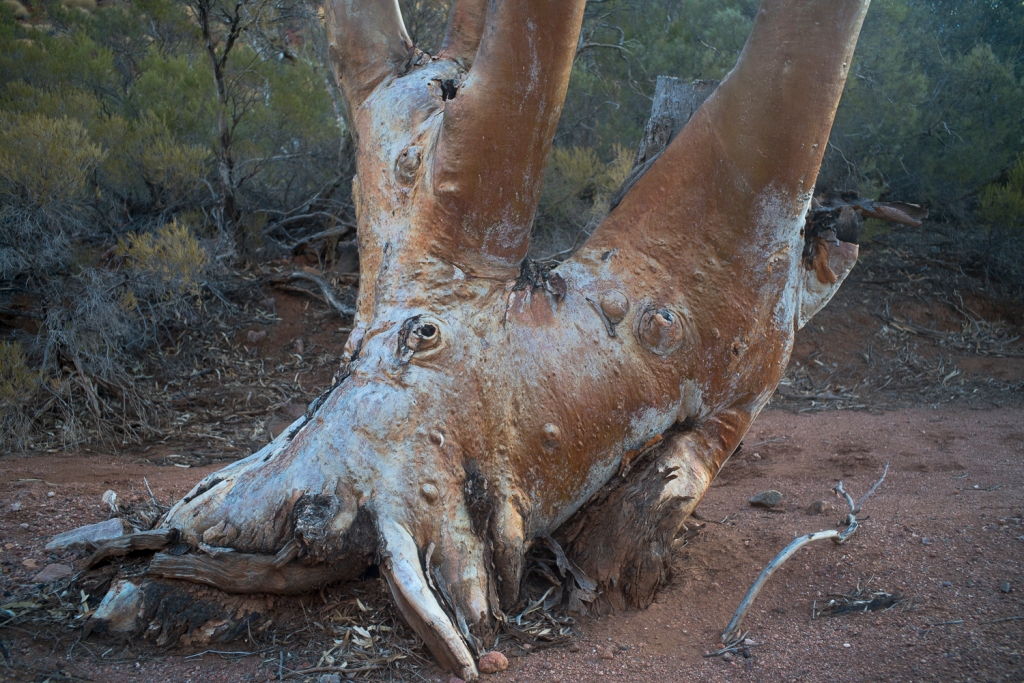At the end of the first day of walking we camped at a wonderful campsite close to Blue Mine Gap on the north western edge of the Gammon Ranges. We were walking in there of Sir Douglas Mawson’s 1906 explorations into the geology of the northern Flinders Ranges. In the 1920s and 1930s Mawson amongst others concentrated his research and fieldwork around the mineralization the northern Flinders Ranges, eruptions of the pre-Cambrian glaciation throughout the Flinders Ranges, the Cambrian strata of the Flinders Range, and the identification of uranium at Mt Painter Inlier, which is about 100 kilometres north east of Leigh Creek and south of the Mawson Plateau. South Australia is one of the world’s focal points for the study of the late pre-Cambrian era and glaciation.
After lunch on the first day we crossed a creek bed. The camels were playing up a bit, and this gave me 5-10 minutes or so to do some photography in and around the creek bed. Surprisingly, the light was still soft due to the continuing cloud cover, and the malaleucas in the creek made a welcome change to the bareness and environmental degradation of the stony hills with the loss of endangered plants and animals from the history of extensive pastoralism since the European occupation of the land.

We had left the Umberatana Station track to walk in, and along, the Blue Mine Creek on the way to the campsite for the night. It was dawning on me that there was a history of extensive mining in the region for copper in the 19th century, and that the systematic regional mapping of the northern Flinders Ranges after 1945 centred around finding coal, petroleum and uranium. Mining was just as crucial as pastoralism in terms of land use. Increasingly it is now eco-tourism that provides the income and employment in the region. As we were walking in the creek bed the Blue Mine Creek it was possible to forget about the legacy of problems left from the way white Australians had not cared for their land when I came across the mineralized rocks. I didn’t know what type of rocks these were–I don’t have that kind of geological knowledge unfortunately. I was just responding to the intense colours in contrast to the spinifex:

You look at these creek beds and wonder, could there not be a sustainable land use of this region that would help to reverse the fragmentation of habitats and loss of biodiversity? This question was reinforced after we’d unloaded the camels for the night and set up our swags, when I was walking amongst the river gums in the creek as I walked to the Blue MIne Gap and then beyond. What came to the fore was the idea of environmental values.

Environmental values roughly mean that a natural object, or more specifically, the ecosystem has a worth in its own right, inherent or intrinsic value, or its own well-being and so worth protecting from unsustainable use; or better still, to improve the condition of the land now and in the future rather than continuing to destroy it. This implies, at a minimum an adaptive management approach to deal with the environmental problems, and consequently much more land needing to be withdrawn from pastoral activity.

It also implies that those things known to cause considerable damage need to be reduced or stopped to enable a sustainable future since national parks and reserves cannot protect everything worth protecting. This means that conservation needs to focus on entire ecosystem management as opposed to single species protection because the components of an ecosystem are largely dependent upon one another

Leave a comment